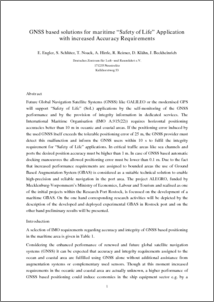|
|
GNSS based solutions for maritime “Safety of Life” Application with increased Accuracy Requirements
Engler, Evelin und Noack, Thoralf und Beckheinrich, Jamila und Hirrle, Angelika und Schlüter, Stefan und Reimer, Roland und Klähn, Dietmar
(2008)
GNSS based solutions for maritime “Safety of Life” Application with increased Accuracy Requirements.
ISBN 978-3-937655-18-5.
![[img]](https://elib.dlr.de/style/images/fileicons/application_pdf.png)  Vorschau |
|
PDF
1MB |
KurzfassungFuture Global Navigation Satellite Systems (GNSS) like GALILEO or the modernised GPS will support “Safety of Life” (SoL) applications by the self-monitoring of the GNSS performance and by the provision of integrity information in dedicated services. The International Maritime Organisation (IMO A.915(22)) requires horizontal positioning accuracies better than 10 m in oceanic and coastal areas. If the positioning error induced by the used GNSS itself exceeds the tolerable positioning error of 25 m, the GNSS provider must detect this malfunction and inform the GNSS users within 10 s to fulfil the integrity requirement for “Safety of Life” applications. In critical traffic areas like sea channels and ports the desired position accuracy must be higher than 1 m. In case of GNSS based automatic docking manoeuvres the allowed positioning error must be lower than 0.1 m. Due to the fact that increased performance requirements are assigned to bounded areas the use of Ground Based Augmentation System (GBAS) is considered as a suitable technical solution to enable high-precision and reliable navigation in the port area. The project ALEGRO, funded by Mecklenburg-Vorpommern’s Ministry of Economics, Labour and Tourism and realised as one of the initial projects within the Research Port Rostock, is focussed on the development of a maritime GBAS. On the one hand corresponding research activities will be depicted by the description of the developed and deployed experimental GBAS in Rostock port and on the other hand preliminary results will be presented. | elib-URL des Eintrags: | https://elib.dlr.de/55256/ |
|---|
| Dokumentart: | Tagungsband |
|---|
| Titel: | GNSS based solutions for maritime “Safety of Life” Application with increased Accuracy Requirements |
|---|
| Autoren: | | Autoren | Institution oder E-Mail-Adresse | Autoren-ORCID-iD | ORCID Put Code |
|---|
| Engler, Evelin | NICHT SPEZIFIZIERT | NICHT SPEZIFIZIERT | NICHT SPEZIFIZIERT | | Noack, Thoralf | NICHT SPEZIFIZIERT | NICHT SPEZIFIZIERT | NICHT SPEZIFIZIERT | | Beckheinrich, Jamila | NICHT SPEZIFIZIERT | NICHT SPEZIFIZIERT | NICHT SPEZIFIZIERT | | Hirrle, Angelika | NICHT SPEZIFIZIERT | NICHT SPEZIFIZIERT | NICHT SPEZIFIZIERT | | Schlüter, Stefan | NICHT SPEZIFIZIERT | NICHT SPEZIFIZIERT | NICHT SPEZIFIZIERT | | Reimer, Roland | NICHT SPEZIFIZIERT | NICHT SPEZIFIZIERT | NICHT SPEZIFIZIERT | | Klähn, Dietmar | NICHT SPEZIFIZIERT | NICHT SPEZIFIZIERT | NICHT SPEZIFIZIERT |
|
|---|
| Datum: | 7 Oktober 2008 |
|---|
| Referierte Publikation: | Nein |
|---|
| Open Access: | Ja |
|---|
| Gold Open Access: | Nein |
|---|
| In SCOPUS: | Nein |
|---|
| In ISI Web of Science: | Nein |
|---|
| Seitenanzahl: | 285 |
|---|
| Herausgeber: | | Herausgeber | Institution und/oder E-Mail-Adresse der Herausgeber | Herausgeber-ORCID-iD | ORCID Put Code |
|---|
| GZVB GmbH, | NICHT SPEZIFIZIERT | NICHT SPEZIFIZIERT | NICHT SPEZIFIZIERT |
|
|---|
| ISBN: | 978-3-937655-18-5 |
|---|
| Status: | veröffentlicht |
|---|
| Stichwörter: | Ground Based Augmentation System (GBAS), Real Time Kinematic Techniques (RTK), GPS, GALILEO, Research Port Rostock, GNSS Performance Assessment Facilty, Maritime Application, Accuracy, Integrity, Performance Quantities |
|---|
| HGF - Forschungsbereich: | Verkehr und Weltraum (alt) |
|---|
| HGF - Programm: | Weltraum (alt) |
|---|
| HGF - Programmthema: | W KN - Kommunikation/Navigation |
|---|
| DLR - Schwerpunkt: | Weltraum |
|---|
| DLR - Forschungsgebiet: | W KN - Kommunikation/Navigation |
|---|
| DLR - Teilgebiet (Projekt, Vorhaben): | W - Projekt GalileoNAV (alt) |
|---|
| Standort: |
Neustrelitz
|
|---|
| Institute & Einrichtungen: | Institut für Kommunikation und Navigation |
|---|
| Hinterlegt von: |
Engler, Dr.-Ing. Evelin
|
|---|
| Hinterlegt am: | 20 Okt 2008 |
|---|
| Letzte Änderung: | 24 Apr 2024 19:19 |
|---|
Nur für Mitarbeiter des Archivs: Kontrollseite des Eintrags
|
|